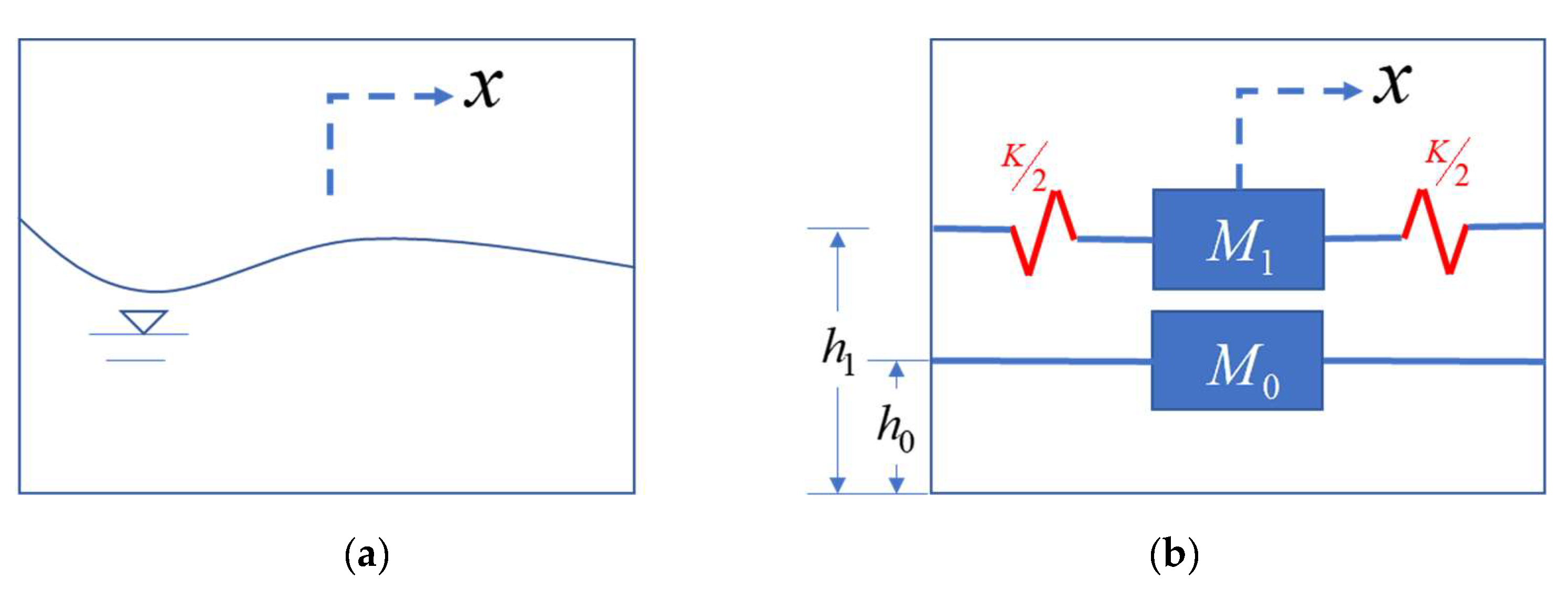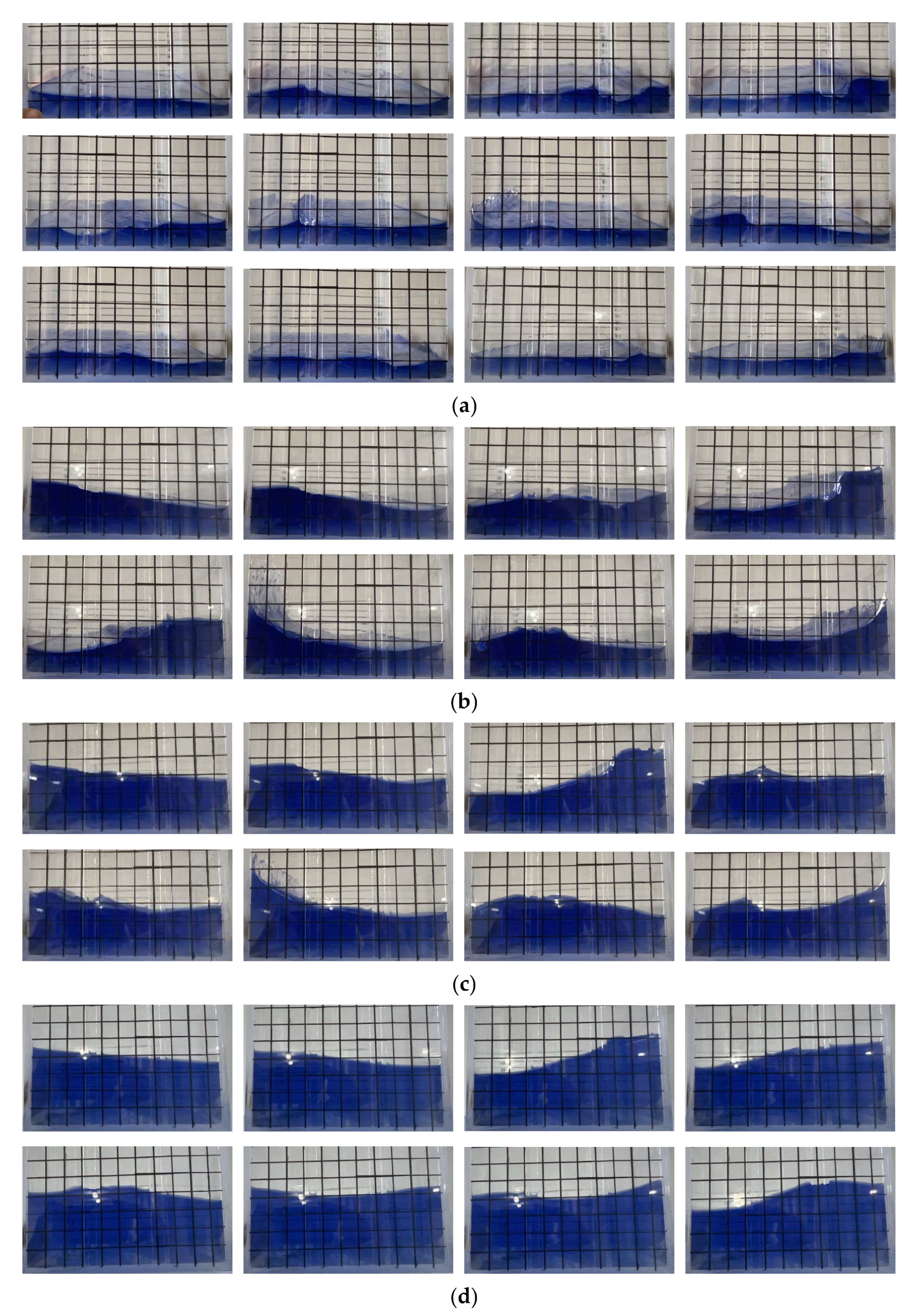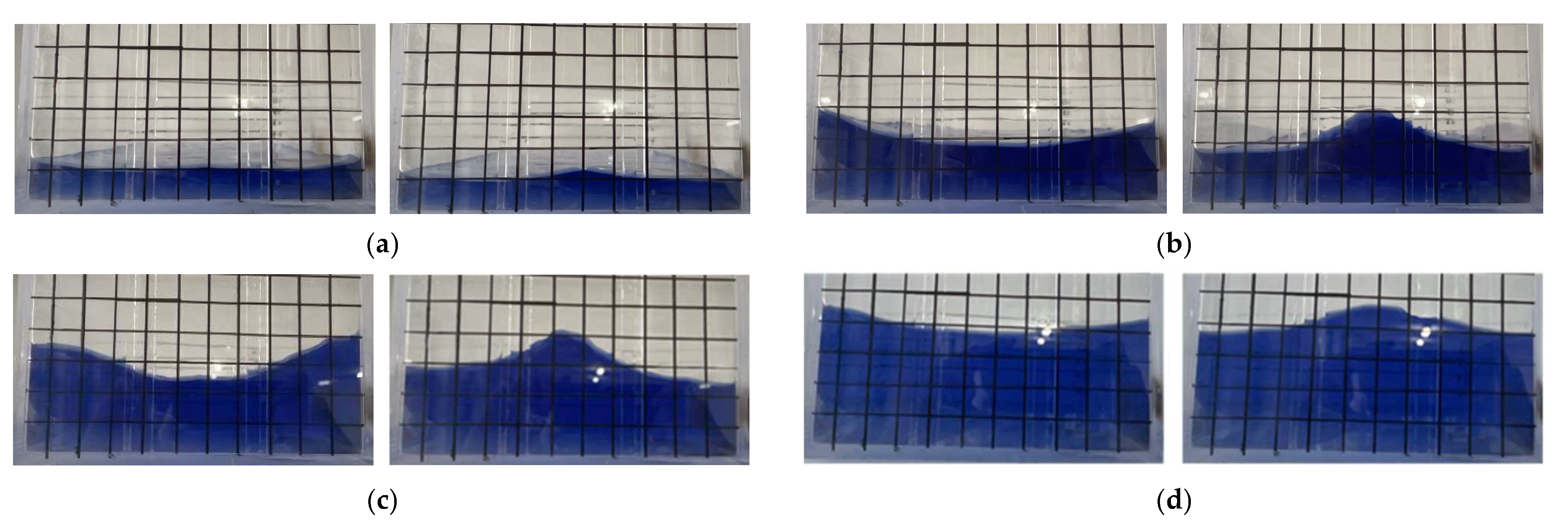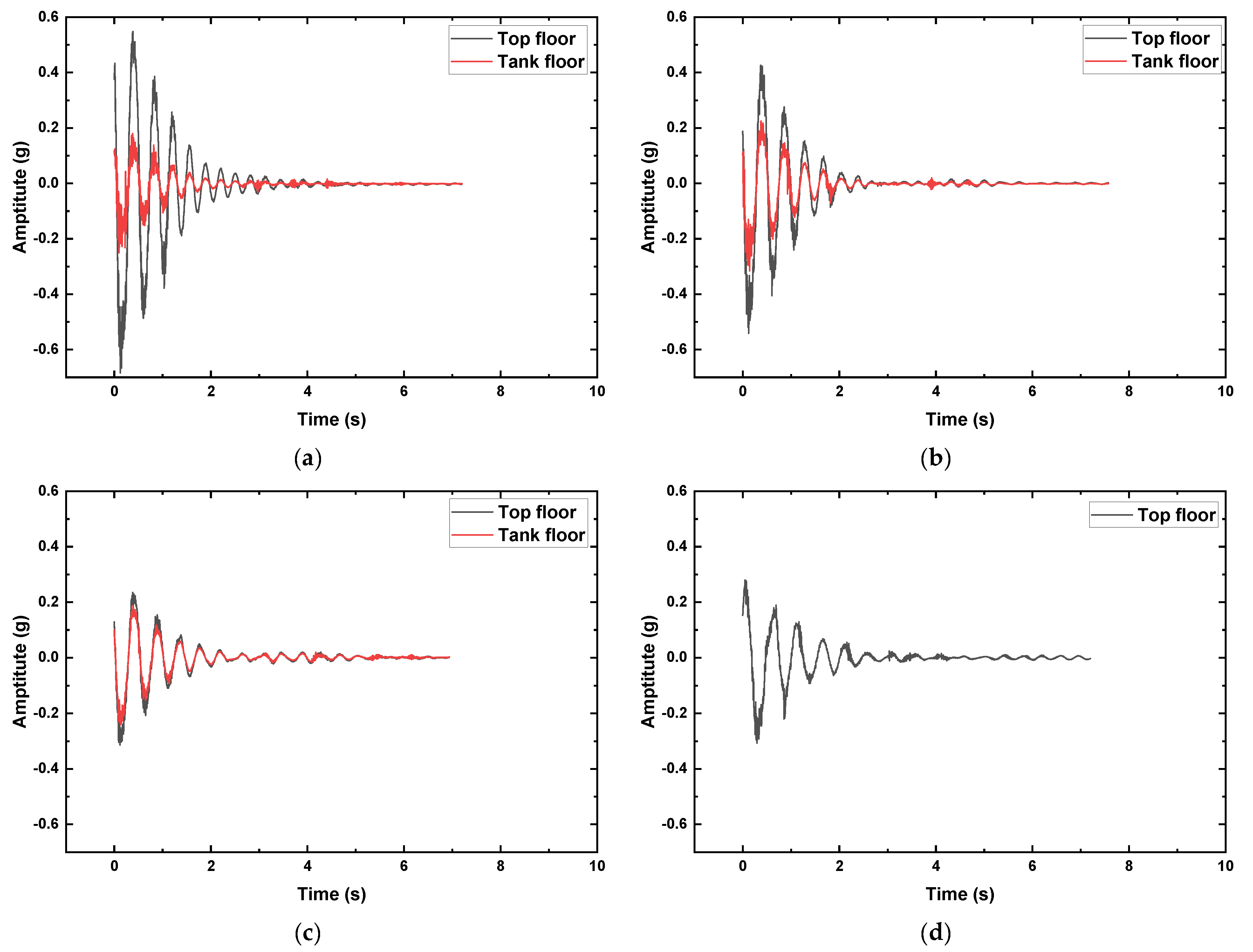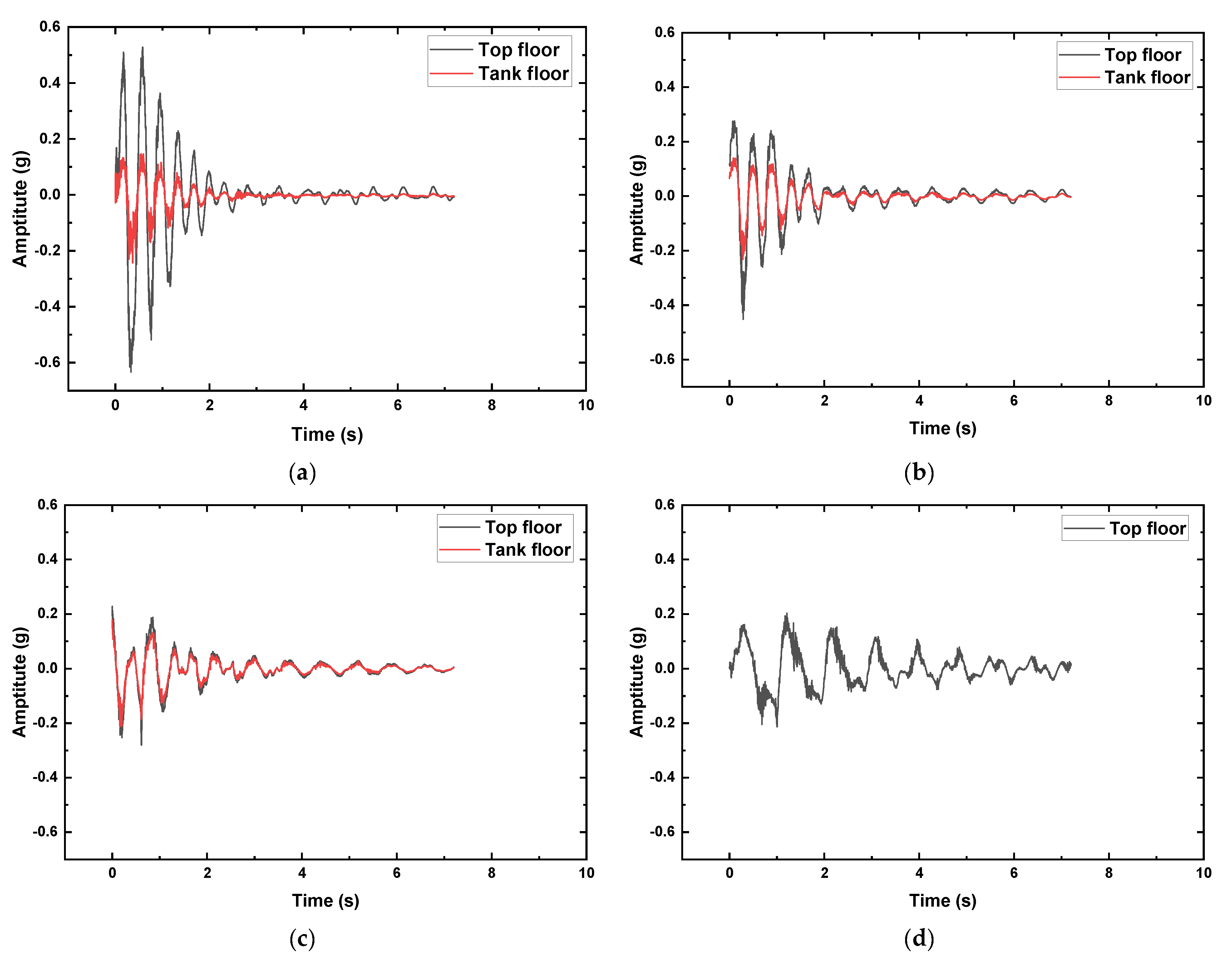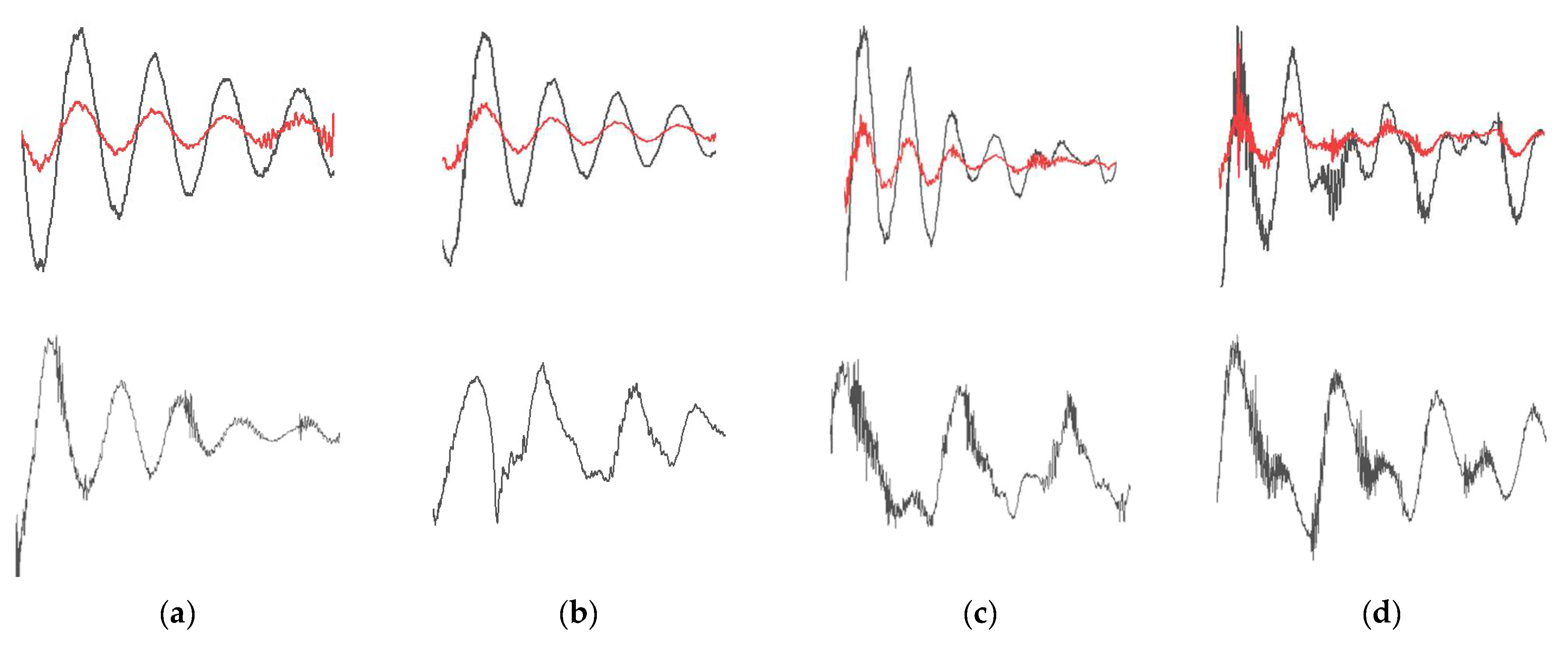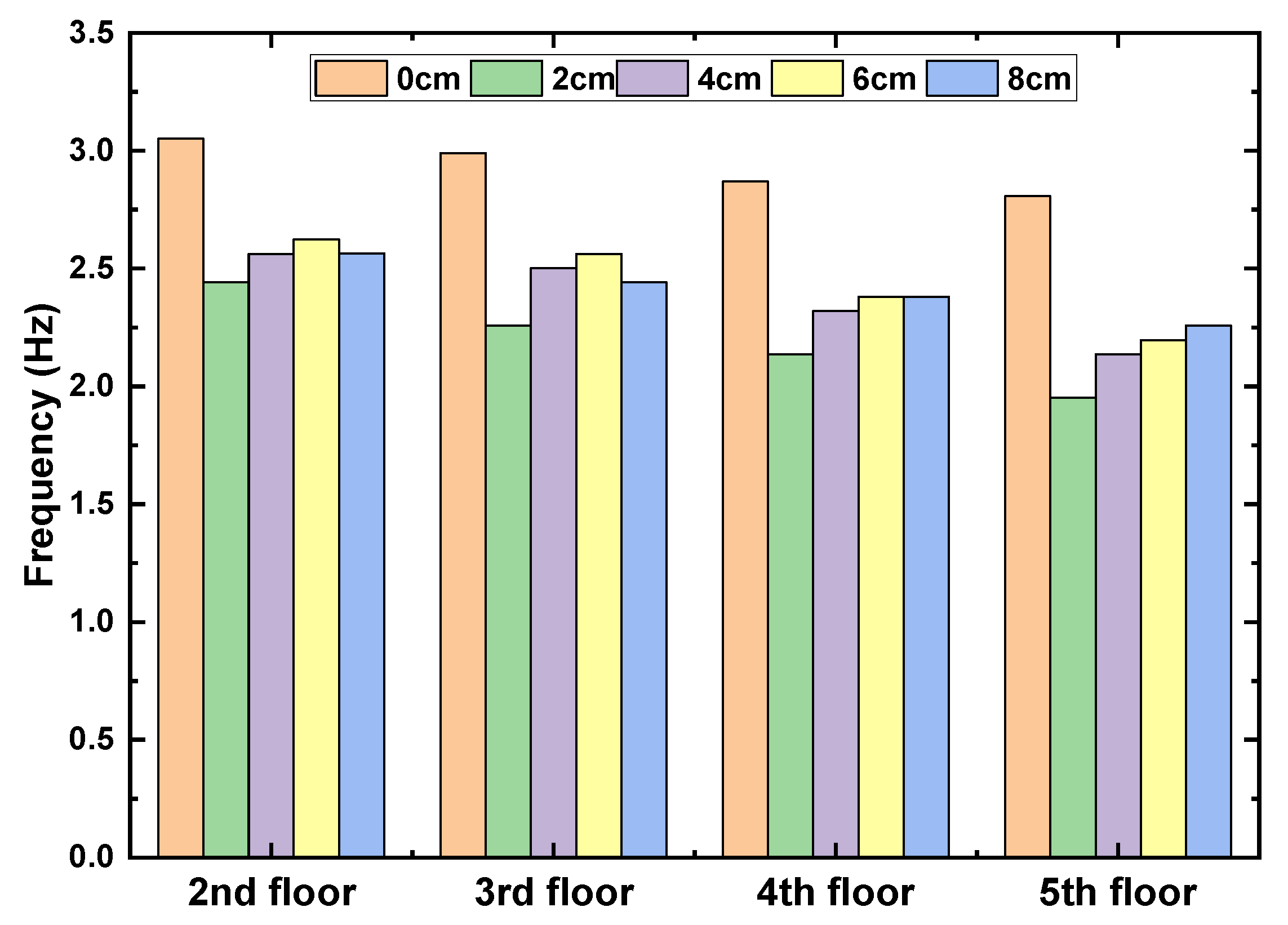1. Introduction
Tuned liquid dampers (TLDs), as a widely used sloshing tank damper, achieve a successful application in the energy dissipation and vibration control of the building [
1,
2,
3,
4,
5]. The main component of TLD is a fixed integral water tank that placed on the structure; when the horizontal external force is applied to the structure, the horizontal displacement emerges and then causes the sloshing of the water in the tank, further leading to the wave with phase difference of around 90° comparing to the structure vibration [
6,
7,
8], so that the impact of wave on the structure is used to resist the external excitation to achieve the purpose of seismic resistance [
9,
10]. The widely used water tanks are of circular, rectangular or ringlike shapes [
11,
12,
13,
14], placed on the top floor to control the wind load and earthquake that applies to the structure [
15], because the device of TLD only relies on the internal liquid rather than additional external energy, which is regarded as an economical and effective vibration reduction measures [
16].
The basic vibration reduction principle of the TLD can be explained in the following way. When the structural vibration occurs to cause the displacement of the device of TLD, further to make the internal liquid slosh [
17], the vibration energy is dissipated through the friction and wave motion between the liquid and the structure [
18]. Such dynamic process includes the accumulation between structural restoring force and liquid sloshing load [
19,
20]. Following the principle, Vandiver and Mitome [
21] first adopted the oil storage tank on an offshore platform as the device of TLD to analyze the dynamical responses of the platform under the condition of wave loading, which primarily validates the performance of seismic resistance of TLD. Due to the results of the abovementioned work, such device is gradually adopted by some researchers to achieve the seismic resistance of ground structures [
22,
23,
24,
25,
26]. In the study by Kareem and Sun [
26], the random seismic response analysis of the TLD-structure system was conducted based on the simulation of the ground motion of a stationary and non-stationary stochastic process. Then, the researchers in Refs. [
27,
28] aimed at the investigation of effects of vibration reduction in TLD device. First, the responses of TLD-structure system under wind and harmonic loads were calculated, while the experiment on the water tank was also conducted. Roy et al. [
29] adopted the way of laboratory experiment, and reported the TLD device with shallow liquid illustrated better performance of seismic resistance in the situation of structural vibration with a small amplitude. After that, the energy dissipation of elevated water tanks and similar structures was also achieved based on TLD passive damping technology [
30]. Furthermore, Ocak et al. [
31] exploited the optimization algorithm to determine the liquid of the TLDs system to make the liquid able to absorb the energy, leading to better damping performance. In the study of Zhang [
32], the nonlinear reduced-order model was proposed to explain the nonlinear behavior of the TLDs, the research also considered the shallow and deep water levels. Moreover, Kamgar et al. [
33] aimed at the single-degree-of-freedom system with a modified TLD. The interaction between the soil and structure was investigated, and the results illustrate that the modified TLD can reduce the reaction well. Ref. [
34] developed a friction pendulum-strengthened TLD and deduced the corresponding analytical model. The finite element method was used to validate the proposed model, and the outcomes can provide good guidance for the multiple seismic performances of a base-isolated structure. In addition, Hsieh et al. [
35] conducted a numerical study on the Tuned mass damper (TMD) and TLD to determine the hybrid performance on the vibration control. The results prove the hybrid TMD and TLD system is of great potential for the application of floating offshore structures. The abovementioned studies pointed out the superiority and the potential of the TLD-structure system for the seismic resistance, but several key issues still need to be solved, such as the fact that (1) the adopted water volume in the TLD has been not investigated well; (2) the optimal placement of the TLDs system needs to be evaluated for the better seismic performance; (3) instead of the qualitative work, more quantitative study is needed. These problems have set some barriers to the development and application of TLDs in the practical engineering structure, therefore, more attention should be paid to this field.
Due to the low cost and good performance on the seismic resistance of the TLD system, in this study, we adopt the placement location and the water level of the tank as the variables, the structural dynamic features (including accelerations of the structure and water sloshing characteristics); the observed phenomena are monitored in the experiment, then the variable analysis is conducted to investigate the influence of the integral water tank on the seismic performance of the slender structure.
The remaining sections are organized as follows:
Section 2 describes the basic damping theory of integral water tank and the experimental design;
Section 3 summarizes the observed experimental phenomenon. Then, we analyze the obtained experimental phenomenon and results in detail; after that, the useful design guide for the integral water tank is proposed in
Section 5. Finally, based on the aforementioned contents, we draw several conclusions and outlooks in
Section 6.
2. Theoretical Background and Experiment Setup
The slender structure has been widely used in practical engineering. However, environmental conditions, such as wind and earthquake, cause the vibration of the engineering structure. In this section, first, the damping theory of the water tank is introduced based on the structural dynamics and fluid dynamics. Then, we design an experimental model of a slender structure with an integral water tank for the subsequent research. The details are described in the following sections.
2.1. Damping Theory of Integral Water Tank
When the external excitation is applied to the tank that is filled with water, the vibration of the tank causes a sloshing in the water. Then, due to the inertia force, a phase difference occurs between the movements of the water body and the structure. As shown in
Figure 1, the emerged inertia force in the water is determined by the mass of the water and the acceleration of the tank. According to structural dynamics, the motion equation of the structure can be written as follows:
where
,
and
stand for the stiffness, damping and mass matrix of the structure, respectively;
,
and
represent the displacement, velocity and acceleration of the structure; and
can be explained as the external excitation.
When the integral water tank is placed in the structure, the existence of the tank changes the damping of the original structure, further to alter the motion status. Regarding this situation, the abovementioned motion equation can be written as follows:
where
is the
n-th circular frequency;
stands for
n-th damping ratio, which can be defined as 0.05 according to Ref. [
25]; and
can be expressed as the external excitation that is influenced by the inertia force in the water. Then, referring to the fluid dynamics, the dynamic coefficient of the sloshing water body caused by the structural vibration can be expressed as follows:
where
represents the mass of the water;
means the
n-th circular frequency of the structure influenced by the sloshing water, which can be obtained based on Housner theory;
g = 9.8 m/s
2, is the gravitational acceleration;
is the water level in the tank;
and
indicate the length of the tank and the acceleration of the water tank placement floor along the vibration direction, respectively.
2.2. The Design of Experimental Model
For the purpose of investigating the influence of integral water tanks on the seismic performance of the slender structure, in this section, we adopt a 5-storey experimental structure with a width–height ratio of 10:1; the design drawing of the model is illustrated in
Figure 2a. The experimental structure is constructed on the steel frame, each floor slab is fixed with the column by bolt riveting. The integral water tank is an acrylic rectangle tank of 22 cm × 22 cm × 25 cm, and the thickness of acrylic plate used for water tank fabrication is 1 cm; for convenient observation, we draw a grid with an interval of 2 cm on the side of the tank (
Figure 2c). Then, we consider the different tank placements and the variable water levels to determine diverse experimental cases. The site of the tank is changed from the second to the top floor, and the water level can be selected from 0 cm to 8 cm with an interval of 2 cm. After that, the external excitation is first applied to the structure to generate initial vibration, meanwhile accelerations on the top floor and in the floor with the tank are collected by the sensors at a sampling rate of 1000 Hz (
Figure 2b). Moreover, the sloshing form of the water during the structural vibration is recorded using the video camera. It should be noted that for better observation and collection of the sloshing characteristics, the filmed photos are gathered based on repeatable experiments.
3. The Description of Experimental Phenomenon
In this section, the sloshing process of the water in the tank is described in detail. At first, the free vibration emerges in the structure due to the external excitation; then, the free vibration causes the water to slosh simultaneously, and the repeated sloshing of the water functions in the structure like a damping system to dissipate energy; finally, the vibration and sloshing achieve a resonance situation and keep a synergetic shaking until the energy dissipates totally.
Aiming at the different water levels,
Figure 3 and
Figure 4 illustrate the water oscillation forms in the sloshing process and in resonance status, respectively. It should be pointed out that all photos were captured when the tank was placed on the top floor due to the limited intensity of external excitation. Meanwhile, during the sloshing process, it can be seen that the placement has a poor influence on the water oscillation forms under the same water level; namely we can observe similar water oscillation forms in the same water level, regardless of the placement. However, the unequal energy of different floors causes a difference in the sloshing amplitude of the water.
Meanwhile, from the video recording, it can be seen that after the emergence of the first sloshing in the water tank with a water level of 2 cm, the tank starts to show the same motion direction as the structure; therefore, due to the existence of inertia, we can observe a sloping water surface in the tank, and the surface in the ahead-of-motion direction is slightly lower than the back one; the discrepancy is approximately half a grid. Then, when the structure achieves the max vibration amplitude, the phase difference caused by the inertia makes the straight line of the water level become a curve, as well as causes the swell in the back. After that, the swell moves along the motion direction of the structure to form two crests in the tank, and the swell occurs again when the first of the two crests arrive at the front plate, but the swell height rises to the height of approximately one grid. Furthermore, accompanying the process of the swell in the front beginning to move to the back plate, there are a total of three crests in the tank; at the same time, the swell in the back plate is moving to the middle. Then, the swells in the front and the back meet in the 1/3 of the tank first to form an impact wave with a height of 2 cm, and then the impact wave hits the back plate to cause a swell with a height of 3 cm. Next, with the change in structure movement direction, the swell with a height of 3 cm transfers to the front plate. In addition, due to the reaction between the reflecting wave and the swell in the back as well as the generated new swell, the height of the subsequent swell is lower than that of the first one. Finally, the energy dissipation makes the water surface keep shaking up and down steadily.
In the case of the water tank with a water level of 4 cm, after the first sloshing emerges on the water, the water surface illustrates a steady variation, namely the surface that is close to the motion direction is slightly higher than the surface in the back; when the structure achieves the max vibration amplitude, the swell with a height of around half grid has occurred in the back plate. Then, the motion direction of the structure is changed, so that the swell starts to move to the front plate. Two crests can be observed in the tank; when two crests hit the front plate, the swell with a height of approximately two grids occurs and then moves to the back accompanying the motion direction of the structure, which alters simultaneously. After that, the swell arriving at the back plate results in the impact wave with a height of approximately five grids, and the impact wave returns to the front plate with the motion direction change in the structure again. However, when the swell returns to the back plate for the second time, the height of the impact wave is reduced to the two-and-a-half-grid size and produces no splash.
Regarding the water tank with a water level of 6 cm, it illustrates a similar sloshing situation to the one with a water level of 4 cm. The swell and impact wave in the back and front plates both show good consistency to the water tank with a water level of 6 cm. However, for the water tank with a water level of 8 cm, the sloshing process only shows the swell in the front and back plates; then, the water achieves the resonance status, and there is no obvious wave impact and splash occurring in the water surface.
Figure 5,
Figure 6,
Figure 7 and
Figure 8 depict the measured acceleration responses of top floor and tank floor when the water tank with different water levels is placed on different floor of the structure, and
Table 1 lists the max acceleration amplitude corresponding to every acceleration response. From the figures, it can be seen that (1) the vibration of each floor is reduced due to the placement of the water tank, and the max amplitude of acceleration shows a declining trend over time, which means the damping that formed by the water exerts a negative effect on the structural vibration; (2) after the external excitation is applied to the structure, the peak points of acceleration responses emerge in the first wave crest or trough as well as the swell phenomenon in the back plate. After that, when the accelerations show another wave trough or crest, the swell occurs in the front plate. The height of such swell is higher than that of the first one in the back plate, and the peak of acceleration response is also smaller than that of the first response; (3)
Table 1 demonstrates that the increased placement height of the water tank reduces the gap between the acceleration peak points in two measurement points; in addition, the alpha, namely the ratio between the measured max acceleration amplitudes of top floor and tank floor, shows a correlation with the tank placement floor (
Figure 9), which means the structural dynamical responses are related to the location of tank placement. Furthermore, regarding each condition of tank placement floor, the mathematical relationship between the alpha and the water level can be obtained by the linear fitting.
4. The Analysis and Discussion on the Results
4.1. The Placement Location
As shown in
Figure 5,
Figure 6,
Figure 7 and
Figure 8, it can be seen that the different placement of the water tank can cause a serious influence on the measured accelerations; the higher placement of the water tank, the more unstable the peak of the acceleration curve, especially for when the tank is placed on the top floor, except the situation of the tank with a water level of 2 cm. The acceleration curves of other tanks all illustrate periodic wave with multiple peaks instead of harmonic wave (
Figure 10); for the occurrence of periodic wave with multiple peaks, such phenomenon can be owed to the impact caused by the swell hitting the plate of the tank, applying some effects on the peaks of the original wave.
Then, we extract the corresponding natural frequencies of each acceleration response and plot them in
Figure 11. From the obtained results, it can be seen that regardless of the placement location, the first natural frequencies of the structure without the water tank are all higher than the structures with the water tank, which means the existence of the water can change the total mass of the original, leading to variations in the frequencies. Meanwhile, with the alternation in the placement, the corresponding frequencies also have been reduced, which means the diverse placement of water tank will affect the distribution of the structural stiffness. The change relation can be summarized as the ascendant placement height of the tank can reduce the stiffness further to lead to the decrease in the frequencies.
The results of
Figure 5,
Figure 6,
Figure 7 and
Figure 8 demonstrate that the damping formed by the water affects the forms of structural acceleration curves. When the water tank is installed on the middle floor of the structure, the measured acceleration curve on the tank floor shows a violent shake in the corresponding peak location, but the curve on the top floor is stable. After several seconds, the discrepancy of the two curves is gradually reduced, which indicates the water tank functions as a damping system to cause the change in the structural vibration form and dissipation in the energy, finally resulting in the stable resonance status of
Figure 4.
For the purpose of study on the damping ratio quantitatively, we adopt the damping ratio calculated equation, which can be written as follows:
where
means the acceleration amplitude corresponding to the
i-th peak of the acceleration and
stands for the acceleration amplitudes corresponding to the
i-th to
j-th peaks of the acceleration. Then, the obtained results are plotted in
Figure 12. From the figure, we can observe that the existence of the water tank can enhance the calculated damping ratio regardless of the measurement point [
30]; at the same time, with the increased height of the tank placement, the calculated damping ratio based on the acceleration that is collected from the tank floor is also raised. However, for the obtained damping ratio based on the acceleration that is collected from the top floor, the curves of the calculated damping ratio first go up, and then decline for the water tank with water levels of 0 cm, 6 cm and 8 cm. Regarding the water level of 2 cm, it proceeds in an ascending trend. The curve of the water level of 4 cm first illustrates a decrease, then a rise. In addition, it should be noted that the average damping ratio of top floor is max one.
4.2. Height of the Water Level
From the obtained accelerations, we can also see that the increased water level transforms the stable harmonic wave form of the original signal to the periodic wave. This situation can be investigated by the video record playback. It is determined that when the wave form of the measured acceleration is changed, the reaction between the swell and plate in the tank emerges. Such process dissipates the energy to cause the occurrence of the change.
Meanwhile, from
Table 1 and
Figure 5,
Figure 6,
Figure 7 and
Figure 8, it can be determined that when the tank is located in the bottom of the structure, there is an obvious difference in amplitude between the top floor and tank floor. Such discrepancy accounts for the 1/4 of amplitude on the top floor, while with the increase in the water level, the gap narrows slightly. The change relationship is depicted in
Figure 9. For the tank that is installed on the high top, the alpha value declines with the increase in the water level.
Regarding the damping ratio curve, it can be seen that when the tank is located in the 2–4th floors, the shallow water level (h = 2 cm) can achieve a higher damping than the other levels, but the tank with a water level of 4 cm can lead to the maximum, followed by the 2 cm, and 8 cm, and 0 cm, the latter two presenting with approximately the same ratios when the tank is placed on the top floor. In conclusion, the abovementioned findings also show good consistency with the existing conclusions of other similar studies, demonstrating namely that the shallow water tank in the structure shows better seismic performance than the deep one.
4.3. The Sloshing Characteristics of the Water Surface
From
Figure 3, it can be observed that in the tank with a shallow water level (
h = 2 cm), the multiple swells can be excited during the sloshing process, and the height of the back swell is higher than that of the front one, both of which move along the vibration direction. Then, regarding the first stage, the spray is mainly the form of swell accompanied by the energy accumulation. After a period of the structural vibration, the front reflected crest hits the back one and then breaks, and the back crest impacts the front plate with high energy. Such splash emerged in this process, far higher than the water level. Furthermore, for the water tank with a water level of 4 and 6 cm, the situations of swell and impact also occurred, as well as the higher splash, but the emerged crest was always single. Moreover, the swell accounts for the water tank with a water level of 8 cm, and the height of swell is weaker than that of the others. We can observe the final water oscillation forms of the water tank with diverse water levels in
Figure 4, which indicates the water tank with different water levels demonstrates the approximately consistent stable water oscillation status.
5. The Design Guide for Integral Water Tank Damping System
Based on the experimental phenomenon and the investigation of the designed parameters, the water level in the water tank does not display a positive correlation with the effects of vibration energy dissipation. For the slender structure, the excess of water in the tank is likely to cause the burden of excessive weight on the top floor. Meanwhile, it can be observed that the vibration energy is dissipated by the water swell, wave impact and plate impact, and with higher placement of the water tank, more damping is applied to the structure, as well as effects on the vibration amplitude. It is advised to install the tank in the middle and upper part of the structure, namely 3/4 to 1 of the overall height is optimal.
However, for the study on the damping, the generated damping effect does not always benefit from the increased water level The obtained experimental data and the theory of shallow water sloshing energy absorption can be utilized to determine the design parameters of the water tank. According to the theory, it is known that the shallow water sloshing can be explained as the water level of the water tank is lower than 1/3 of the plate height of the water tank in the vibration direction; meanwhile, in the experiment, the optimal water level is 2 cm, the corresponding ratio is 1/11, and the lesser amount of water cannot fill the tank uniformly. For the comprehensive analysis, it has been suggested that the 2–4 cm water level can be adopted for the good seismic performance, namely the water level should constitute 1/11 to 1/10 of the plate height in the vibration direction.
6. Conclusions and Outlooks
This study conducts an experiment to research the application of the integral water tank in the seismic performance of the slender structure. Several designed parameters, such as placement location and the height of the water level, are examined. Meanwhile, we also observe the sloshing characteristics of the water, and the experimental phenomenon is analyzed and discussed theoretically and experimentally. Finally, aiming at the design of the tank, we summarize a useful guide for the same or similar situation. According to the comparison and analysis of the experimental phenomenon, we can draw several conclusions as follows:
- (1)
The installation of the integral water tank causes an obvious attenuation in the structural acceleration responses and the maximum acceleration amplitude, and the first natural frequency declines, which means the existence of the tank applies significant effects on the structural vibration characteristics.
- (2)
The experimental vibration process suggests that the energy dissipation is mainly realized through the wave motion of the water and the reaction and the impact of the occurred swell, leading to the suppression in the structural vibration. In addition, the excitation of the external force and the different water level cause the diverse initial forms of the water, suggesting there are various waveforms of the water in the tank in the first stage; however, the final oscillation characteristics of the water achieve good consistency in the stable status.
- (3)
The placement location of the water tank has a key influence on the energy dissipation. The higher of the placement, the more violent of the vibration amplitude and the acceleration, the more intense of the water motion, so that more energy can be absorbed.
- (4)
The change in the water level illustrates a correlation to the structural damping. Compared to other floors, there is an obvious increase in the calculated damping based on the collected acceleration from the tank floor, and the placement on the top floor obtains optimal seismic performance. Meanwhile, the water tank with a water level of 4 cm on the top floor can achieve the maximum damping, followed by the water level of 2 cm.
Regarding the outlooks, there are two limitations that need to be further studied in the future. For instance, although the water motion characteristics are observed well due to the transparency of the acrylic material, the displacement of each floor is not measured. In addition, only the top and tank floors are measured due to the inadequate acceleration sensors, which cannot completely reflect the distribution of the structural vibration.
